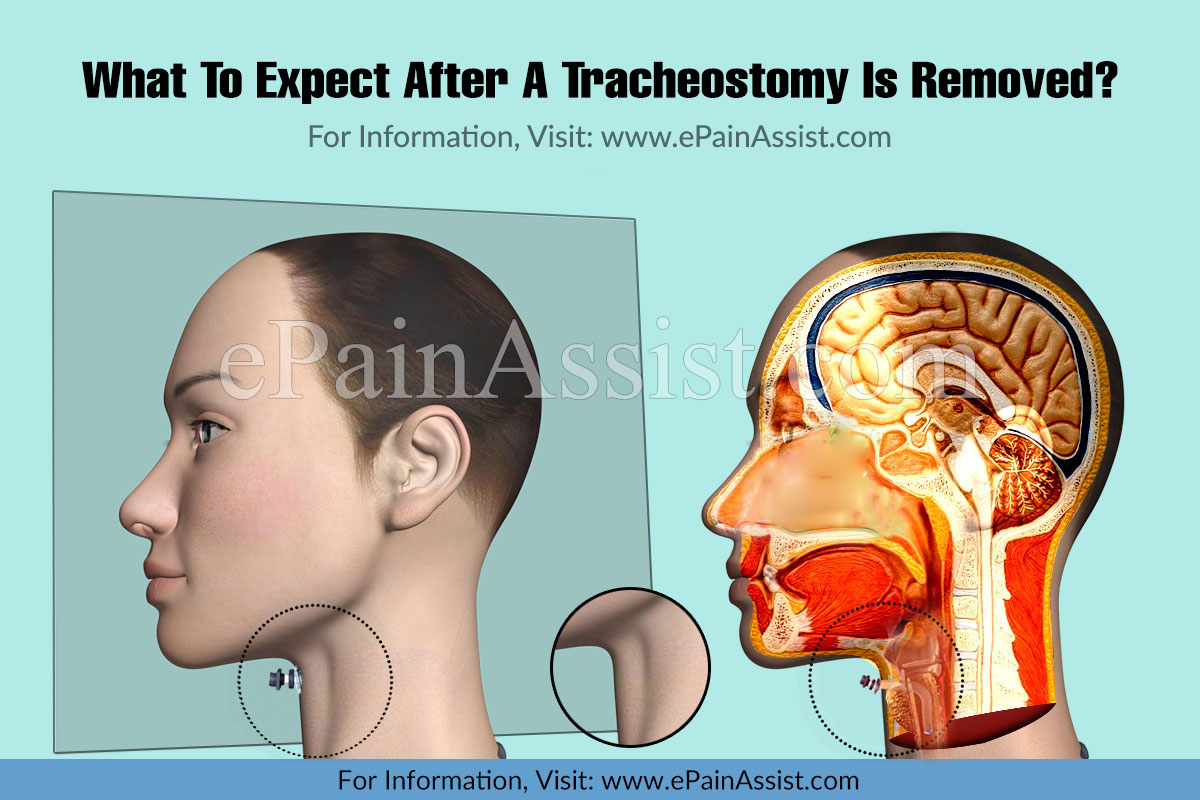People who have tracheostomies often feel variations in their lifestyle in association with swallowing, eating, and drinking, and these changes persist even after the removal of tracheostomy.1,2
After the breathing tube is removed the skin edges are sealed completely but still the patients will have difficulties while speaking and coughing.3
Speaking is very difficult because speech is generated from the vocal cord at the back of the throat.4

What To Expect After A Tracheostomy Is Removed?
The human body has two parts in its breathing system, the upper airway and the lower airway. The nose, mouth, throat, and larynx form the upper airway whereas the windpipes, air tubes, and air sacs consist of the lower airway. Like the branches of the tree, the windpipes (trachea) are further divided into smaller tubes that help to breathe and to clear the airway.
However, the tracheostomy tube should be taken off as soon as is possible and hence should be cut back as quickly as possible to resume breathing without obstruction. This information is often useful for patients who have had the tracheostomy tube removed.1,2
In general, people with a tracheostomy often have problems with their routine lifestyle such as speaking, coughing, eating, drinking, and swallowing. In many instances, these difficulties persist despite the removal of the tracheostomy tube however it gets better over time.
Furthermore, patients who have not fully recovered from the illness of the operation will require a breathing tube. Some of the aspects that patients should be fully aware of following removal of tracheostomy include:
- Noisy Breathing Sound: When the patient develops a noisy squeaking sound during breathing, they should immediately call for assistance before things getting worse.
- Feeling Breathless And Uncomfortable: Similarly, when the patient suffers shortness of breath or panicky, they should require immediate hospitalization for further treatment.
- Soreness: Post-surgery, there can be soreness on the skin edges, and you may have trouble swallowing in the initial few days. It may take a couple of days or more to get used to breathing and expect to feel better each day.3
What Else The Patients Should Be Aware Of After Removal?
There are a few things the patients need to follow for the speedy recovery and when to reach for immediate medical assistance.
Recovery After Removal: When the medical issues are resolved the tracheostomy tube would be removed. However, the wound will take 1-2 weeks to heal completely but during this period if the injury becomes wet or starts to develop an infection, check with the nurse or GP immediately.
- Require frequent dressings than usual and also when the dressing changes color to green or red.
- When the wound takes more time for healing or looks more noticeable.
- Do not stop taking pain killers unless or until advised by your doctor because they are aimed to avoid infections and relieve soreness.4
A tracheostomy is performed to provide airway to patients who are on a mechanical ventilator or have trouble swallowing or suffering from chronic lung disorders (aspiration). Aspiration is a pneumonic issue wherein the individuals breathe foreign objects such as food, saliva, or some other material that induces vomit or heartburn.
When the patient is unable to cough up their mucus your healthcare provider will suggest a tracheostomy for the suction of mucus from the lungs. A tracheostomy may be performed as planned or emergency depending on the requirement.
- Raimonde, Anthony J. “Tracheostomy.” StatPearls [Internet]., U.S. National Library of Medicine, 30 Nov. 2020, www.ncbi.nlm.nih.gov/books/NBK559124/.
- “When Should the Tracheostomy Tube Be Removed?” Latest Medical News, Clinical Trials, Guidelines – Today on Medscape, 12 Nov. 2019, www.medscape.com/answers/865068-32841/when-should-the-tracheostomy-tube-be-removed
- “Tracheostomy: What to Expect at Home.” MyHealth.Alberta.ca Government of Alberta Personal Health Portal, https://www.myhealth.alberta.ca/Health/aftercareinformation/pages/conditions.aspx?hwid=zy1382
- Contributor, NT. “Tracheostomy 2: Managing the Weaning of a Temporary Tracheostomy.” Nursing Times, 4 Aug. 2019, www.nursingtimes.net/clinical-archive/respiratory-clinical-archive/tracheostomy-2-managing-the-weaning-of-a-temporary-tracheostomy
